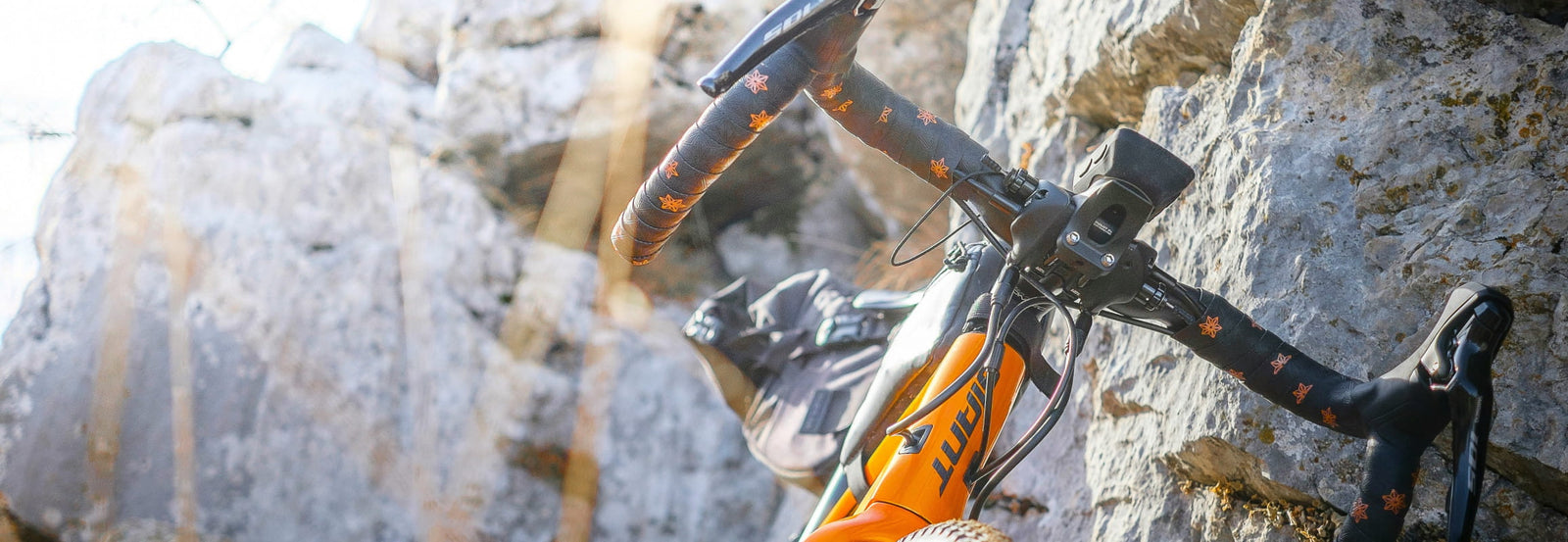Since Cyclocross already existed – why was Gravel even invented? Those who are familiar (and love their Cyclocross Bike and/or Gravel Bike) may wonder about our provocative question. In fact, it is justified because the two types of bicycles at least visually resemble each other. However, there are also a lot of exciting differences – especially in terms of the area of use.
A bike with a drop handlebar has a certain something, which is why the invention of the Gravel Bike a few years ago made many cyclists happy. Previously, the drop bar of the Road Bikes was stylish but simply not suitable for the masses. Spoiler alert... Cyclocross bikes, their adventurous variant, are not either.
The question of whether a Cyclocross Bike corresponds to a Gravel and whether the two types of bicycles can simply be exchanged can be clearly denied. There are more differences than similarities between Gravel Bike and Cyclocrosser. Here you will find out what the bicycles have in common, but also what one can do better than the other!
Area of use Cyclocross vs. Purpose Gravel Bike
If you compare the purpose of Cyclocross and Gravel, you quickly see that the basic idea is completely different. While the Gravel Bike is more or less the current variant of the trekking bike, a Cyclocrosser is a competition device.
- This is what a Cyclocross Bike is built for:
To understand what distinguishes a Cyclocross Bike, we need to dig a little into the history of bicycle racing. Bicycles were made race-ready quite soon after their invention, that is, made into racing bikes. The racing bike has only one catch. It works best on smooth and dry roads. To make the races more exciting, bicycle races in the terrain were invented. But that was not enough; so that the racing fun did not have to be completely canceled during the winter season, it was decided that at least deep mud or loose sand should be part of the race track in places. Therefore, in addition to the relentless propulsion of the wheels, a pinch of bad weather suitability was built in, so they also work in the dirt. Ride comfort? Who needs that? The races are rather short, you'll manage!
That was when the Cyclocross Bike or CX Bike was invented. Cyclocross races are also known for a special feature: the bicycle is carried. A competition without a carry section? How boring! The route is chosen so that the bike must be carried over particularly nasty terrain at least once. Since these races push the riders to their limits, they are limited to shorter distances and at most 2 hours.

Lightning fast, even when the mud reaches the bottom bracket – that's what a Cyclocross Bike is built for. Image © Cannondale
✅ competition-ready
✅ fast
✅ suitable for mud and loose surfaces
✅ light, as it must be carried
❌ little riding comfort
❌ not suitable for everyday use
> Sounds good? Here are the Cyclocross Bikes in the online shop
- What a Gravel Bike can do:
A Gravel Bike can do a little bit of everything. Commuting, bike tours, bike trips, shopping, or day trips, all are possible without any problems. Training or trail rides are also possible. For this, the Gravel Bike is as versatile as possible, and the riding comfort on long distances is a particularly important criterion. The Gravel Bike is definitely a sporty bike, but it's more of a long-distance runner than a sprinter. It works on almost any surface and is also equipped with everything you might need on the go. However, that doesn't mean that Gravel Bikes don't like to race! More and more gravel races are springing up, and the comfortable Gravel Bike can compete with others here.

The typical Gravel can do a bit of everything. Image © Rondo
✅ suitable for long distances
✅ versatile
✅ tours with luggage are possible
✅ comfortable
❌ more equipment = more weight
❌ more comfort = less speed
> Exactly your thing? Then check out our Gravel Bikes in the shop!
Cyclocross vs. Gravel - in short:
|
In general, the comparison shows that a Cyclocross is a specialized sports device, while the Gravel Bike can be used as a versatile means of transport. These completely different purposes result in two quite different designs and equipment lists. |
Cyclocross vs. Gravel - what are the similarities?
The road bike handlebars is the obvious similarity. But this first impression is deceiving, the comparison shows: Gravel Bike and Cyclocross have few other similarities!

The top view of the cockpit is quite similar for Cyclocross and Gravel. Image © Bombtrack
Durability is an important point!
Both types of bicycles must be robust and durable, but for completely different reasons. The durability of a gravel bike has a different focus than that of a cyclocross bike. The gravel should not have any breakdowns on long distances. The CX bike must not give up under maximum load and especially the drivetrain must not wear out immediately despite the impact of a paste of water, dust, and sand.
The difference between Gravel and Cyclocross Bike
If there were no differences between cyclocross and gravel, you could simply ride any of the two bicycles. But there are differences, and they ensure that you can buy the perfect bike for every purpose! That's why you should consider in advance what you plan to do with your bike.
Cyclocross Frame vs. Gravel Frame
The geometry of a cyclocross differs significantly from the more relaxed geo of the gravel bike. It is built for technically demanding races, which means the geo is fast, aggressive, designed for propulsion, and at the same time more maneuverable. To overcome obstacles, a cyclocross usually gives you more ground clearance, so the bottom bracket is higher than it is on a gravel bike.
The gravel bike puts you in a relaxed seating position, which is comfortable enough for long bikepacking days in the saddle. It is also important that the gravel offers you a safe, stable road position, especially when you are traveling with luggage - it doesn't matter whether it is a child seat, your groceries, or your camping equipment. "Camping equipment" is an important keyword! A gravel needs a lot of loading, while for cyclocross it is enough if the rider and two water bottles can ride along.
Other frame conditions are also influenced by the area of use of the two types of bicycles. A cyclocross bike convinces with high rigidity and little flexibility, while for gravel it is rather the opposite. A gravel bike usually has no suspension fork and no frame damper (although there are now some gravel bikes that come with dampers). To make the overall work of art more comfortable, the frame is more flexible, and the material provides some damping.
Cyclocross Frame & Gravel Bike Frame – Conclusion:
|
|
Gearing
To save weight and make it easier to carry the bike, the cyclocross bike today in most cases 1x11 or 1x12 drivetrains are installed. The range is rather limited, the bike should be fast, ready. An 11-36 cassette is the typical CX equipment. An important point here is always the durability of the group. Mud, sand, and dust wear on the material, a cheap shifting group would be scrap in no time. Therefore, only high-quality, robust components are mounted here.
Many Gravel Bikes also have a 1x drivetrain, but 2x drivetrains are not uncommon either, after all, many gears with lots of range make the bike veryversatile. Shimano's GRX, a frequently installed gravel drivetrain, is available in different versions from 2x12 to 1x12 to 2x10 – depending on what you plan, you will definitely find the right drivetrain.
Tires
Off-road or mud-friendly? That is the fundamental question when you take a closer look at the tires of our two candidates.
The UCI prescribes a tire width of 33mm for cyclocross races, which most manufacturers follow for their CX bikes. The cyclocross also gets a little extra space around the tire so that no dirt can get stuck in the gap. The tread pattern is also designed so that the dirt does not remain stuck despite a lot of grip.
Most Gravel Bikes can be ridden with different tire widths , 35 to 50mm are not a problem for many models. City tires, rain tires, winter tires... everything is allowed on the gravel.
For both types of bicycles, 28” is the common wheel size.
Tire Rules for CX & GRVL:
|
|
Gravel or Cyclocross – what is the equipment like?
The cyclocross bike is designed for very specific sporting events. A gravel bike is intended for everyday use and tours. These fundamental differences are reflected in the bike's equipment.
To ensure that the cyclocross bike can be fast in races, it has no equipment, because less weight makes it faster. The fact that the bike is occasionally shouldered during competition is another argument for weight reduction at all corners and ends! You get nothing here except bottle holders!
With the gravel bike , the considerations are completely different. The bike should be as versatile, comfortable, and suitable for everyday use as possible, which requires a certain amount of equipment. It has everything from the factory or at least the mounting points for it.
All or Nothing: The Equipment for Gravel Bike & Cyclocross
|
|

You can see it at first glance - our picture does not show a Cyclocross, but a Gravel! Picture © Focus
Cyclocross vs Gravel in weight comparison
The Cyclocross must be fast, so it weighs as little as possible. A CX bike will always be slightly heavier than a road bike. After all, it should be durable and resistant to abrasion. Nevertheless, it wants to win competitions and is therefore light. You should plan for around 8 kilos.
The Gravel often has good everyday equipment or touring gear. Additionally, it should be as robust as possible, which also makes the weight climb. Without attachments, you are traveling with 8 to 10 kilos, with a luggage rack and co it becomes 12 to just under 14 kilos.
What does a Gravel Bike weigh, what does a CX weigh?
|
|
Class or mass? How does it look with Gravel Bike and Cyclocrosser?
Gravel bikes are the bikes of the moment and more are being added with each model year. Many bicycle brands have several Gravel Bikes in their range to meet the different wishes of the growing gravel community. Affordable, top models, more everyday-friendly or touring bikes - the selection is huge. With the Cyclocross Bike it's different. The CX fan base is manageable, there are the corresponding bikes from different manufacturers, but they usually deliver one model; maybe there are one or two different variants, but that's about it.
The differences and similarities in the overview
|
Feature/Equipment |
Cyclocross |
Gravel |
|
Handlebar |
Road bike handlebar |
Road bike handlebar or gravel handlebar with flare |
|
Durability |
robust construction for durability under maximum load |
robust construction for durability under continuous load |
|
Ride Comfort |
Speed is key! |
comfortable enough for long distances |
|
Damping |
no damping |
material damping, occasional dampers and suspension fork |
|
Weight |
as light as possible for maximum efficiency, about 8 kilos |
a bit heavier for durability and load capacity, 8 to 14 kilos, depending on the equipment |
|
Gears |
mostly 1x11 or 1x12 |
many gear options available |
|
Equipment |
no equipment |
maximum equipment available or retrofittable |
|
Load Capacity |
as light as possible for optimal speed |
stable enough for bikepacking luggage |
|
Selection |
few models |
huge selection |
|
E-Bike? |
no electric versions |
E-Gravel bikes are available, trend increasing |
Which bike works for bikepacking?
Bikepacking is becoming more popular with each season, so the question of the right bike is often asked: Can you bikepack better on a cyclocross bike or a gravel bike? If you've read this far, you can answer this question yourself. The right bike for this popular sport is clearly the gravel bike!
|
You can also compete in a cyclocross race on a gravel bike. You probably won't win it, as the bike is neither light nor fast enough. But it is likely to finish the race. Conversely, you might be able to ride a cyclocross bike to the office, and very quickly, though not comfortably. It is not suitable for bike tours or bikepacking. |
So the decision is actually quite simple:
|
|
Is that always true?
We have now explained the differences and similarities between gravel and cyclocross. But is that ALWAYS true? Generally yes, but the boundaries between the different types of bikes are starting to blur. There are endurance road bikes that are comfortable enough for long tours. There are lightweight gravel bikes bred for speed. You should always take a closer look at the mix of frame geometry and equipment, then you'll know if the gravel bike you want to buy can do what you intend. It's easier when buying a CX bike. Most cyclocross bikes are and remain mud machines with a speed guarantee. Long distance is not their forte.
Cyclocross Bike & Gravel Bike – what else is there?
Now you know the two bikes that like it rough, or muddy. But there is also a completely clean way to be on the road with a road bike handlebar, because of course, there is also the good old road bike! The MTB would be a real alternative, especially if you want to go off-road. For bikepacking and everyday use, a trekking bike is actually very close to the capabilities of a gravel bike.
What about E-bike versions?
As you have already seen in our table – there are plenty of E-gravel bikes. E-cyclocross bikes have not appeared yet, they simply wouldn't work in races. If you want a little assistance here, an E-road bike would be the only alternative.
Title image © Alessio Soggetti on Unsplash





